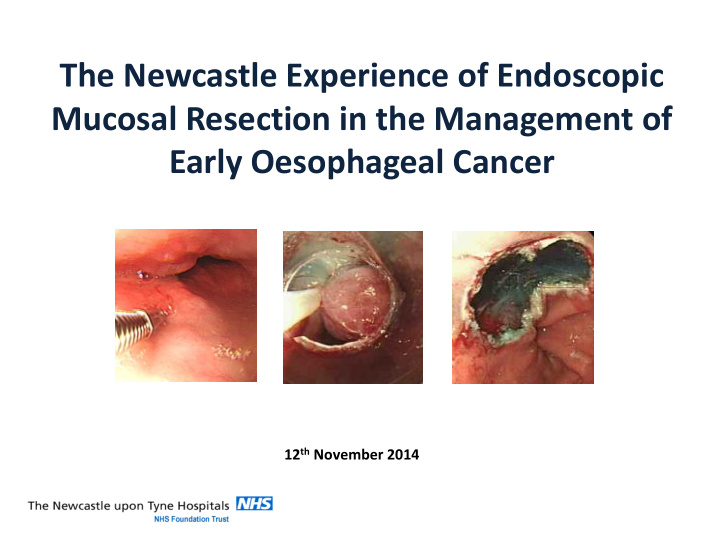



The Newcastle Experience of Endoscopic Mucosal Resection in the Management of Early Oesophageal Cancer 12 th November 2014
The Growing Role for EMR • Increasing focus on early detection and treatment of oesophageal cancer • Endoscopic mucosal resection (EMR) provides important staging information and treatment for early cancers 1 1. Long-term Efficacy and Safety of Endoscopic Resection for Patients With Mucosal Adenocarcinoma of the Esophagus. Pech O, May A, Manner H et al. Gastroenterology 2014 146(3):652-660
The Growing Role for EMR • Increasing focus on early detection and treatment of oesophageal cancer • Endoscopic mucosal resection (EMR) provides important staging information and treatment for early cancers 1 • UK experience of EMR is limited • Mortality rates associated with surgery have fallen significantly • Long-term outcomes following surgery for early cancer are excellent 1. Long-term Efficacy and Safety of Endoscopic Resection for Patients With Mucosal Adenocarcinoma of the Esophagus. Pech O, May A, Manner H et al. Gastroenterology 2014 146(3):652-660
Aims Review the introduction of EMR in the Northern Oesophago-Gastric Unit
Methods • All oesophageal EMRs since 2006 • Prospective database • All patients discussed in MDM • Suction cap technique 2 • All EMRs performed by surgeons • Circumferential biopsies taken after EMR performed • Surgery recommended for patients with submucosal disease 3 or involved resection margins 2. Randomized trial on endoscopic resection-cap versus multiband mucosectomy for piecemeal endoscopic resection of early Barrett's neoplasia. Pouw RE, van Vilsteren, Peters FP et al. Gastrointest Endosc 2011;74(1):35-43 3. Lymph node metastasis in early esophageal adenocarcinoma. Griffin SM, Burt AD, Jennings NA. Ann Surg 2011;254(5):731-6
Results • 86 EMRs performed on 66 patients • Median age 71 years (range 38-84) • Overall complication rate 3.5% • 2 patients had radiological evidence of perforation • 1 repeat endoscopy for bleeding • Adenocarcinoma identified in 33 specimens • Represented upstaging from HGD in nine patients
Results Endoscopic Surgery* Surveillance (n=3) (n=17) T1a Surgery (n=23) (n=3) Radical Radiotherapy Adenocarcinoma (n=3) (n=33) Surgery (n=4) T1b (n=10) Unfit/Declined Surgery (n=6)
Results Endoscopic Surgery* Surveillance (n=3) (n=17) T1a Surgery pT1aN0 n=2 No residual tumour n=1 (n=23) (n=3) Radical Radiotherapy Adenocarcinoma (n=3) (n=33) pT1bN2 n=1 Surgery pT1bN0 n=2 (n=4) No residual tumour n=1 T1b (n=10) Unfit/Declined Surgery (n=6)
Results Endoscopic Surgery* Surveillance (n=3) (n=17) T1a Surgery (n=23) (n=3) Radical Radiotherapy Adenocarcinoma (n=3) (n=33) Surgery (n=4) T1b (n=10) Unfit/Declined Surgery (n=6)
Results Endoscopic Surgery Surveillance (n=3) (n=17) T1a Surgery (n=23) (n=3) Radical Radiotherapy Adenocarcinoma (n=3) (n=33) Surgery (n=4) T1b (n=10) Unfit/Declined Surgery (n=6)
Results Endoscopic Surgery Surveillance (n=3) (n=17) pT1aN0 n=2 T1a Surgery pT1bN0 n=1 (n=23) (n=3) Radical Radiotherapy Adenocarcinoma (n=3) (n=33) Surgery (n=4) T1b (n=10) Unfit/Declined Surgery (n=6)
Outcomes • Median follow up of 19 months (4-74) • Three T1a patients required surgery after initial surveillance at 15, 17 and 27 months • Single T1b patients treated with oesophagectomy developed metastatic recurrence 24 months post-EMR
Conclusions • EMR playing an important role in the staging and management of early oesophageal cancer • All patients undergoing EMR should be staged and discussed at MDM • Surveillance following EMR is essential to allow treatment of disease recurrence • Treatment with EMR does not appear to disadvantage patients who develop local disease recurrence • Care must be taken with submucosal disease which has the potential for nodal and metastatic dissemination • Importance of treatment of residual Barrett’s with ablation
Acknowledgements L Dunn, S Wahed, R Jones K Wynne, D Karat, J Shenfine, N Hayes, A Immanuel, SM Griffin H Jaretzke
Recommend
More recommend